3900NRS: Neonatal Jaundice Case Study: Pathophysiology & Care
VerifiedAdded on 2023/06/12
|10
|2477
|334
Essay
AI Summary
This essay provides a comprehensive analysis of a neonatal jaundice case study, employing the ISBAR framework to detail the neonate's condition and care. It critically evaluates the pathophysiology of neonatal jaundice, differentiating between physiological and pathological causes, and interprets the assessment data from the case study to understand the severity of the condition. The essay further explores the crucial role of the nurse in establishing a family-centered care approach, emphasizing communication, respect, and collaboration with the family. Applying these principles to the case study, the essay highlights the importance of addressing the family's psychological distress and empowering them in the care process. The conclusion reinforces the diagnosis of pathological hyperbilirubinemia due to birth injuries and stresses the significance of family-centered care in ensuring quality outcomes.
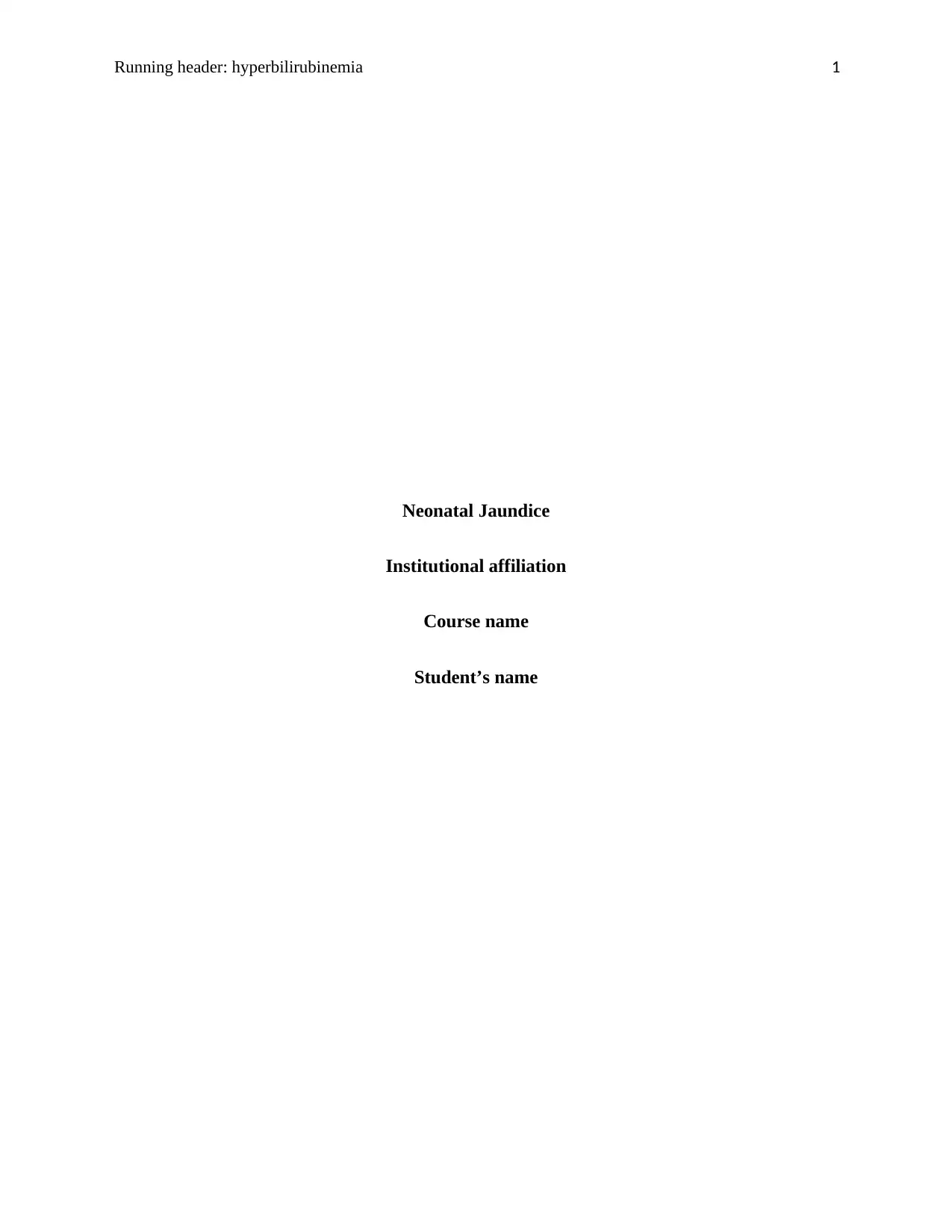
Running header: hyperbilirubinemia 1
Neonatal Jaundice
Institutional affiliation
Course name
Student’s name
Neonatal Jaundice
Institutional affiliation
Course name
Student’s name
Paraphrase This Document
Need a fresh take? Get an instant paraphrase of this document with our AI Paraphraser

Neonatal Jaundice 2
Introduction
This essay will, one, describe a case study of a neonate with jaundice using the ISBAR
guidelines. That is the identification, situation, background, assessment and recommendation.
Two, critically analyze the pathophysiology of neonatal jaundice. It will critically evaluate the
clinical research on the neonate so as to discuss the pathophysiology of the clinical problem that
is being presented by the neonatal jaundice case study. Three, the assessment data that was
obtained from the case study will be accurately interpreted. Four, the role of the nurse in
creating/establishing a family centered care approached when caring for a neonate will be
discussed. Five, the family-centered care will be applied to the family of the neonate with
jaundice. Six, throughout the essay, the discussions will be evidence-based. Lastly, there will be
a conclusion that will summarize the whole essay.
Baby Jennifer Case Study.
Identification
A female neonate born at 33+3/40 gestation via spontaneous vertex delivery (SVD). It was as a
result of premature rupture of membranes. She sustained facial bruises during her birth as a result
of her presentation. Her mother Sian is a 41 multiparous woman, gravida 5, para 5+0.
Situation
Currently, she is admitted to the Special Care Nursery (SCN) where she is receiving care.
initially, it was as a result of mild respiratory distress. This was managed through supporting the
respiratory system by mechanical ventilation. She can now breathe normally. Currently, at two
days old, she was diagnosed to be having jaundice.
Introduction
This essay will, one, describe a case study of a neonate with jaundice using the ISBAR
guidelines. That is the identification, situation, background, assessment and recommendation.
Two, critically analyze the pathophysiology of neonatal jaundice. It will critically evaluate the
clinical research on the neonate so as to discuss the pathophysiology of the clinical problem that
is being presented by the neonatal jaundice case study. Three, the assessment data that was
obtained from the case study will be accurately interpreted. Four, the role of the nurse in
creating/establishing a family centered care approached when caring for a neonate will be
discussed. Five, the family-centered care will be applied to the family of the neonate with
jaundice. Six, throughout the essay, the discussions will be evidence-based. Lastly, there will be
a conclusion that will summarize the whole essay.
Baby Jennifer Case Study.
Identification
A female neonate born at 33+3/40 gestation via spontaneous vertex delivery (SVD). It was as a
result of premature rupture of membranes. She sustained facial bruises during her birth as a result
of her presentation. Her mother Sian is a 41 multiparous woman, gravida 5, para 5+0.
Situation
Currently, she is admitted to the Special Care Nursery (SCN) where she is receiving care.
initially, it was as a result of mild respiratory distress. This was managed through supporting the
respiratory system by mechanical ventilation. She can now breathe normally. Currently, at two
days old, she was diagnosed to be having jaundice.
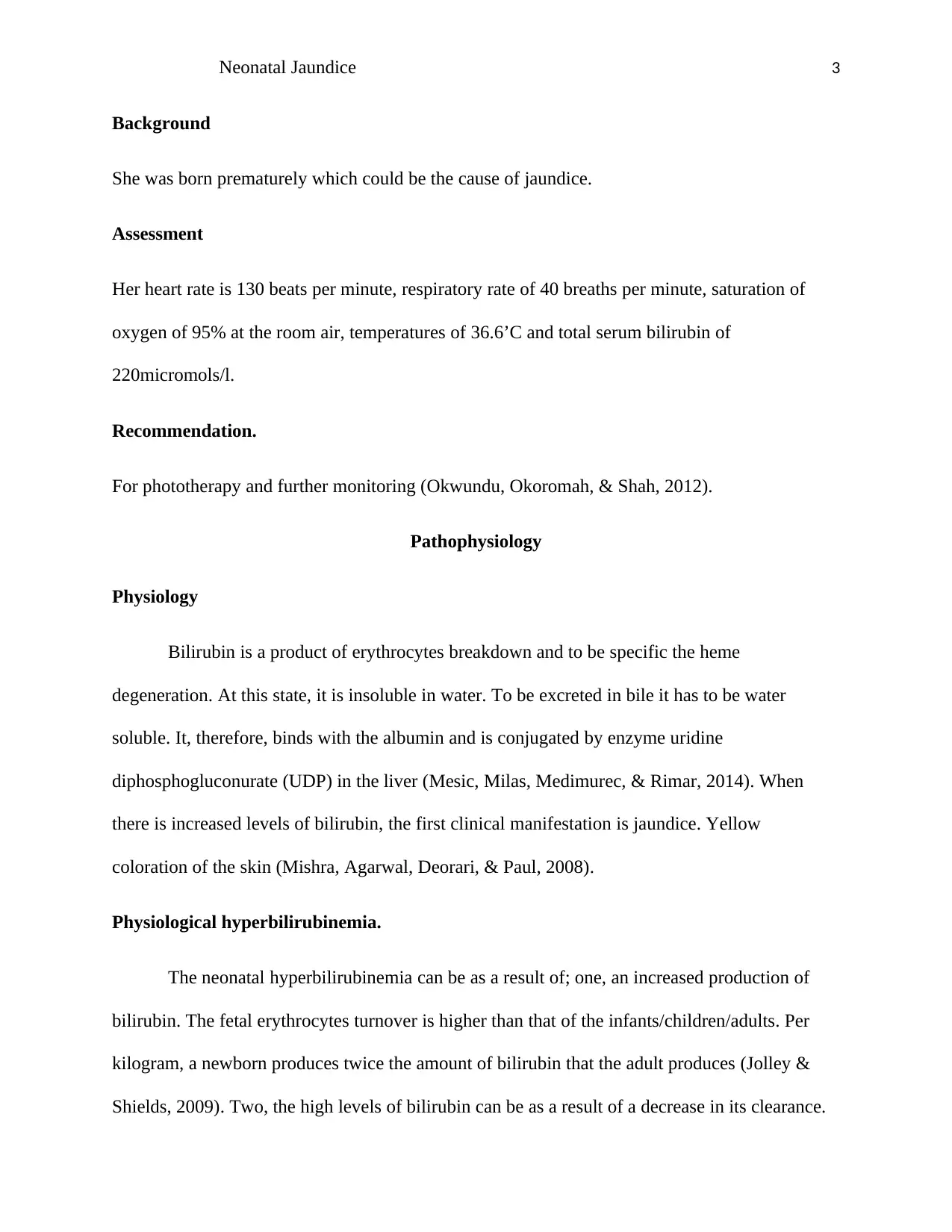
Neonatal Jaundice 3
Background
She was born prematurely which could be the cause of jaundice.
Assessment
Her heart rate is 130 beats per minute, respiratory rate of 40 breaths per minute, saturation of
oxygen of 95% at the room air, temperatures of 36.6’C and total serum bilirubin of
220micromols/l.
Recommendation.
For phototherapy and further monitoring (Okwundu, Okoromah, & Shah, 2012).
Pathophysiology
Physiology
Bilirubin is a product of erythrocytes breakdown and to be specific the heme
degeneration. At this state, it is insoluble in water. To be excreted in bile it has to be water
soluble. It, therefore, binds with the albumin and is conjugated by enzyme uridine
diphosphogluconurate (UDP) in the liver (Mesic, Milas, Medimurec, & Rimar, 2014). When
there is increased levels of bilirubin, the first clinical manifestation is jaundice. Yellow
coloration of the skin (Mishra, Agarwal, Deorari, & Paul, 2008).
Physiological hyperbilirubinemia.
The neonatal hyperbilirubinemia can be as a result of; one, an increased production of
bilirubin. The fetal erythrocytes turnover is higher than that of the infants/children/adults. Per
kilogram, a newborn produces twice the amount of bilirubin that the adult produces (Jolley &
Shields, 2009). Two, the high levels of bilirubin can be as a result of a decrease in its clearance.
Background
She was born prematurely which could be the cause of jaundice.
Assessment
Her heart rate is 130 beats per minute, respiratory rate of 40 breaths per minute, saturation of
oxygen of 95% at the room air, temperatures of 36.6’C and total serum bilirubin of
220micromols/l.
Recommendation.
For phototherapy and further monitoring (Okwundu, Okoromah, & Shah, 2012).
Pathophysiology
Physiology
Bilirubin is a product of erythrocytes breakdown and to be specific the heme
degeneration. At this state, it is insoluble in water. To be excreted in bile it has to be water
soluble. It, therefore, binds with the albumin and is conjugated by enzyme uridine
diphosphogluconurate (UDP) in the liver (Mesic, Milas, Medimurec, & Rimar, 2014). When
there is increased levels of bilirubin, the first clinical manifestation is jaundice. Yellow
coloration of the skin (Mishra, Agarwal, Deorari, & Paul, 2008).
Physiological hyperbilirubinemia.
The neonatal hyperbilirubinemia can be as a result of; one, an increased production of
bilirubin. The fetal erythrocytes turnover is higher than that of the infants/children/adults. Per
kilogram, a newborn produces twice the amount of bilirubin that the adult produces (Jolley &
Shields, 2009). Two, the high levels of bilirubin can be as a result of a decrease in its clearance.
⊘ This is a preview!⊘
Do you want full access?
Subscribe today to unlock all pages.

Trusted by 1+ million students worldwide
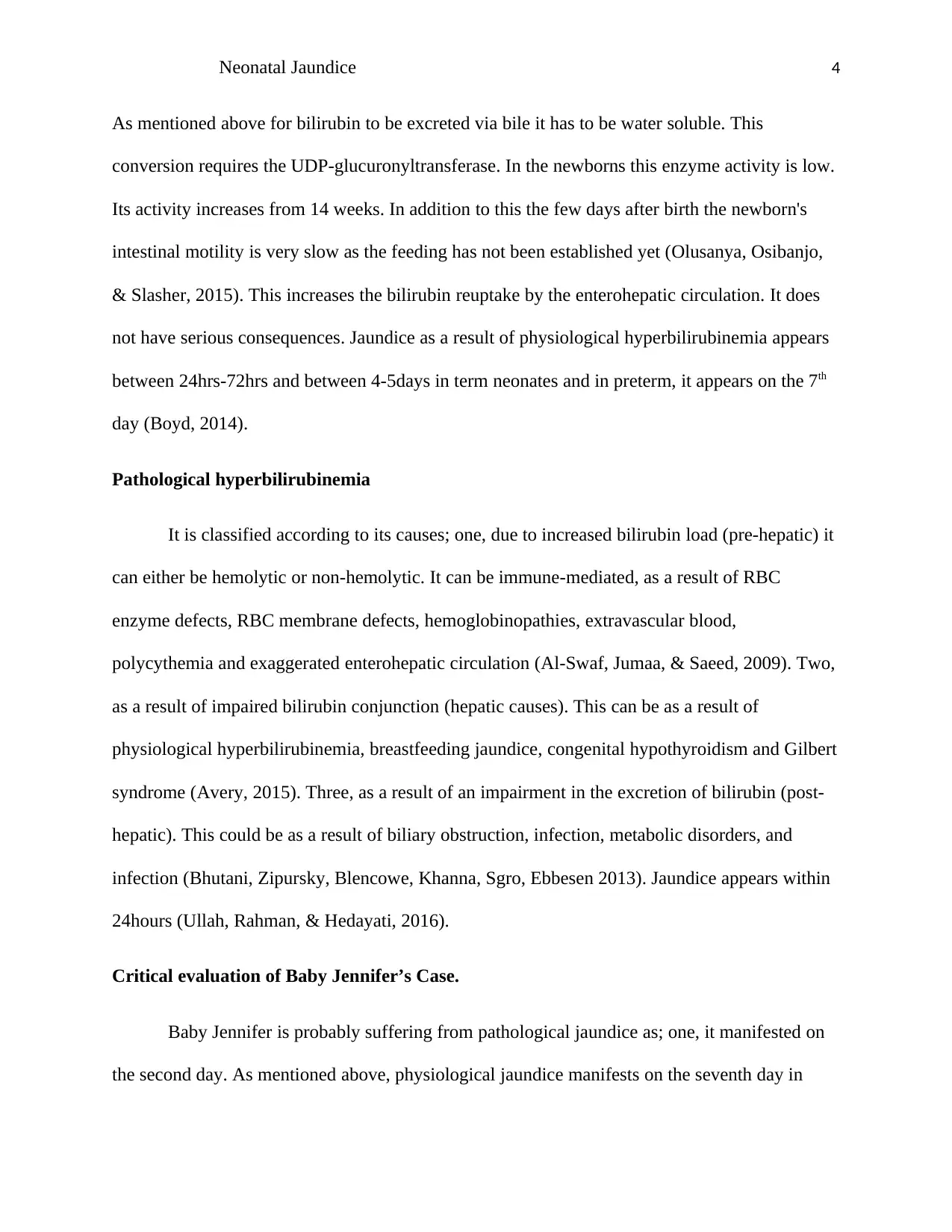
Neonatal Jaundice 4
As mentioned above for bilirubin to be excreted via bile it has to be water soluble. This
conversion requires the UDP-glucuronyltransferase. In the newborns this enzyme activity is low.
Its activity increases from 14 weeks. In addition to this the few days after birth the newborn's
intestinal motility is very slow as the feeding has not been established yet (Olusanya, Osibanjo,
& Slasher, 2015). This increases the bilirubin reuptake by the enterohepatic circulation. It does
not have serious consequences. Jaundice as a result of physiological hyperbilirubinemia appears
between 24hrs-72hrs and between 4-5days in term neonates and in preterm, it appears on the 7th
day (Boyd, 2014).
Pathological hyperbilirubinemia
It is classified according to its causes; one, due to increased bilirubin load (pre-hepatic) it
can either be hemolytic or non-hemolytic. It can be immune-mediated, as a result of RBC
enzyme defects, RBC membrane defects, hemoglobinopathies, extravascular blood,
polycythemia and exaggerated enterohepatic circulation (Al-Swaf, Jumaa, & Saeed, 2009). Two,
as a result of impaired bilirubin conjunction (hepatic causes). This can be as a result of
physiological hyperbilirubinemia, breastfeeding jaundice, congenital hypothyroidism and Gilbert
syndrome (Avery, 2015). Three, as a result of an impairment in the excretion of bilirubin (post-
hepatic). This could be as a result of biliary obstruction, infection, metabolic disorders, and
infection (Bhutani, Zipursky, Blencowe, Khanna, Sgro, Ebbesen 2013). Jaundice appears within
24hours (Ullah, Rahman, & Hedayati, 2016).
Critical evaluation of Baby Jennifer’s Case.
Baby Jennifer is probably suffering from pathological jaundice as; one, it manifested on
the second day. As mentioned above, physiological jaundice manifests on the seventh day in
As mentioned above for bilirubin to be excreted via bile it has to be water soluble. This
conversion requires the UDP-glucuronyltransferase. In the newborns this enzyme activity is low.
Its activity increases from 14 weeks. In addition to this the few days after birth the newborn's
intestinal motility is very slow as the feeding has not been established yet (Olusanya, Osibanjo,
& Slasher, 2015). This increases the bilirubin reuptake by the enterohepatic circulation. It does
not have serious consequences. Jaundice as a result of physiological hyperbilirubinemia appears
between 24hrs-72hrs and between 4-5days in term neonates and in preterm, it appears on the 7th
day (Boyd, 2014).
Pathological hyperbilirubinemia
It is classified according to its causes; one, due to increased bilirubin load (pre-hepatic) it
can either be hemolytic or non-hemolytic. It can be immune-mediated, as a result of RBC
enzyme defects, RBC membrane defects, hemoglobinopathies, extravascular blood,
polycythemia and exaggerated enterohepatic circulation (Al-Swaf, Jumaa, & Saeed, 2009). Two,
as a result of impaired bilirubin conjunction (hepatic causes). This can be as a result of
physiological hyperbilirubinemia, breastfeeding jaundice, congenital hypothyroidism and Gilbert
syndrome (Avery, 2015). Three, as a result of an impairment in the excretion of bilirubin (post-
hepatic). This could be as a result of biliary obstruction, infection, metabolic disorders, and
infection (Bhutani, Zipursky, Blencowe, Khanna, Sgro, Ebbesen 2013). Jaundice appears within
24hours (Ullah, Rahman, & Hedayati, 2016).
Critical evaluation of Baby Jennifer’s Case.
Baby Jennifer is probably suffering from pathological jaundice as; one, it manifested on
the second day. As mentioned above, physiological jaundice manifests on the seventh day in
Paraphrase This Document
Need a fresh take? Get an instant paraphrase of this document with our AI Paraphraser
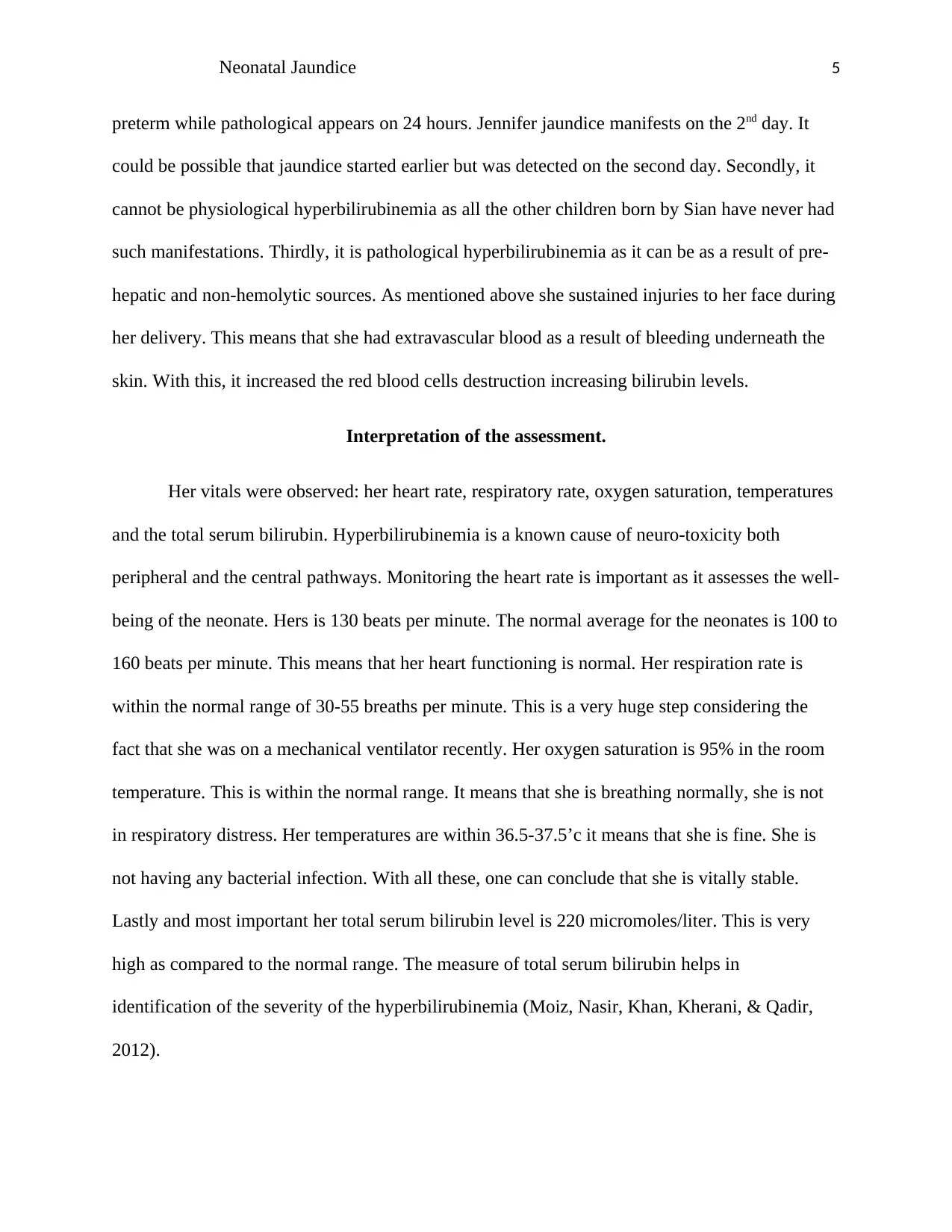
Neonatal Jaundice 5
preterm while pathological appears on 24 hours. Jennifer jaundice manifests on the 2nd day. It
could be possible that jaundice started earlier but was detected on the second day. Secondly, it
cannot be physiological hyperbilirubinemia as all the other children born by Sian have never had
such manifestations. Thirdly, it is pathological hyperbilirubinemia as it can be as a result of pre-
hepatic and non-hemolytic sources. As mentioned above she sustained injuries to her face during
her delivery. This means that she had extravascular blood as a result of bleeding underneath the
skin. With this, it increased the red blood cells destruction increasing bilirubin levels.
Interpretation of the assessment.
Her vitals were observed: her heart rate, respiratory rate, oxygen saturation, temperatures
and the total serum bilirubin. Hyperbilirubinemia is a known cause of neuro-toxicity both
peripheral and the central pathways. Monitoring the heart rate is important as it assesses the well-
being of the neonate. Hers is 130 beats per minute. The normal average for the neonates is 100 to
160 beats per minute. This means that her heart functioning is normal. Her respiration rate is
within the normal range of 30-55 breaths per minute. This is a very huge step considering the
fact that she was on a mechanical ventilator recently. Her oxygen saturation is 95% in the room
temperature. This is within the normal range. It means that she is breathing normally, she is not
in respiratory distress. Her temperatures are within 36.5-37.5’c it means that she is fine. She is
not having any bacterial infection. With all these, one can conclude that she is vitally stable.
Lastly and most important her total serum bilirubin level is 220 micromoles/liter. This is very
high as compared to the normal range. The measure of total serum bilirubin helps in
identification of the severity of the hyperbilirubinemia (Moiz, Nasir, Khan, Kherani, & Qadir,
2012).
preterm while pathological appears on 24 hours. Jennifer jaundice manifests on the 2nd day. It
could be possible that jaundice started earlier but was detected on the second day. Secondly, it
cannot be physiological hyperbilirubinemia as all the other children born by Sian have never had
such manifestations. Thirdly, it is pathological hyperbilirubinemia as it can be as a result of pre-
hepatic and non-hemolytic sources. As mentioned above she sustained injuries to her face during
her delivery. This means that she had extravascular blood as a result of bleeding underneath the
skin. With this, it increased the red blood cells destruction increasing bilirubin levels.
Interpretation of the assessment.
Her vitals were observed: her heart rate, respiratory rate, oxygen saturation, temperatures
and the total serum bilirubin. Hyperbilirubinemia is a known cause of neuro-toxicity both
peripheral and the central pathways. Monitoring the heart rate is important as it assesses the well-
being of the neonate. Hers is 130 beats per minute. The normal average for the neonates is 100 to
160 beats per minute. This means that her heart functioning is normal. Her respiration rate is
within the normal range of 30-55 breaths per minute. This is a very huge step considering the
fact that she was on a mechanical ventilator recently. Her oxygen saturation is 95% in the room
temperature. This is within the normal range. It means that she is breathing normally, she is not
in respiratory distress. Her temperatures are within 36.5-37.5’c it means that she is fine. She is
not having any bacterial infection. With all these, one can conclude that she is vitally stable.
Lastly and most important her total serum bilirubin level is 220 micromoles/liter. This is very
high as compared to the normal range. The measure of total serum bilirubin helps in
identification of the severity of the hyperbilirubinemia (Moiz, Nasir, Khan, Kherani, & Qadir,
2012).

Neonatal Jaundice 6
Family-centered care.
Family-centered care (FCC) is used to describe the optimal health care that is
experienced by the families of the sick child (Bamm, & Rosenbaum, 2008). In most cases the
following terms are used in describing FCC; partnership and collaboration approach to decision
making in the healthcare sector. To have a family-centered care the following principles have to
be followed; one, sharing of information among different medical professionals. Two, respecting
and honoring differences. Three, partnering and collaboration with different firms/departments
for the wellbeing of the patient. Four, negotiating the desired outcomes. Five, care in the context
of family and community. The care given to the child should focus on the family, school, his/her
daily activities, and the quality of life he/she will be living within the society/community (Kuo,
Houtrow, Arango, Kuhlthau, Simmons & Neff, 2012)
In Baby Jennifer’s case, the family is psychologically disturbed. This is their first child to
have jaundice and the other five are not under their care. This worries them. Family-centered
care will be of benefit in Jennifer care deliver. The nurse caring for her will be able to establish a
family-centered care by; one sharing unbiased and complete information with Jennifer’s’ family.
The information should be affirming and useful. Two, by honoring and respecting Jennifer’s’
family’s choices and perspectives. This includes their beliefs, knowledge, cultural background
and values. The nurse should be culturally sensitive. Thirdly, ensuring that Jennifer’s family
feels supported and encouraged in participating in the care of Jennifer and decision making.
Four, the nurse should ensure that Jennifer’s family is empowered to discover their strengths and
to build confidence and make decisions and choices about their well-being and health. The nurse
should also ensure that there are collaboration and partnership between different team members.
Five, ensure that the care given to Jennifer is family friendly and by recognizing the benefits of
Family-centered care.
Family-centered care (FCC) is used to describe the optimal health care that is
experienced by the families of the sick child (Bamm, & Rosenbaum, 2008). In most cases the
following terms are used in describing FCC; partnership and collaboration approach to decision
making in the healthcare sector. To have a family-centered care the following principles have to
be followed; one, sharing of information among different medical professionals. Two, respecting
and honoring differences. Three, partnering and collaboration with different firms/departments
for the wellbeing of the patient. Four, negotiating the desired outcomes. Five, care in the context
of family and community. The care given to the child should focus on the family, school, his/her
daily activities, and the quality of life he/she will be living within the society/community (Kuo,
Houtrow, Arango, Kuhlthau, Simmons & Neff, 2012)
In Baby Jennifer’s case, the family is psychologically disturbed. This is their first child to
have jaundice and the other five are not under their care. This worries them. Family-centered
care will be of benefit in Jennifer care deliver. The nurse caring for her will be able to establish a
family-centered care by; one sharing unbiased and complete information with Jennifer’s’ family.
The information should be affirming and useful. Two, by honoring and respecting Jennifer’s’
family’s choices and perspectives. This includes their beliefs, knowledge, cultural background
and values. The nurse should be culturally sensitive. Thirdly, ensuring that Jennifer’s family
feels supported and encouraged in participating in the care of Jennifer and decision making.
Four, the nurse should ensure that Jennifer’s family is empowered to discover their strengths and
to build confidence and make decisions and choices about their well-being and health. The nurse
should also ensure that there are collaboration and partnership between different team members.
Five, ensure that the care given to Jennifer is family friendly and by recognizing the benefits of
⊘ This is a preview!⊘
Do you want full access?
Subscribe today to unlock all pages.

Trusted by 1+ million students worldwide
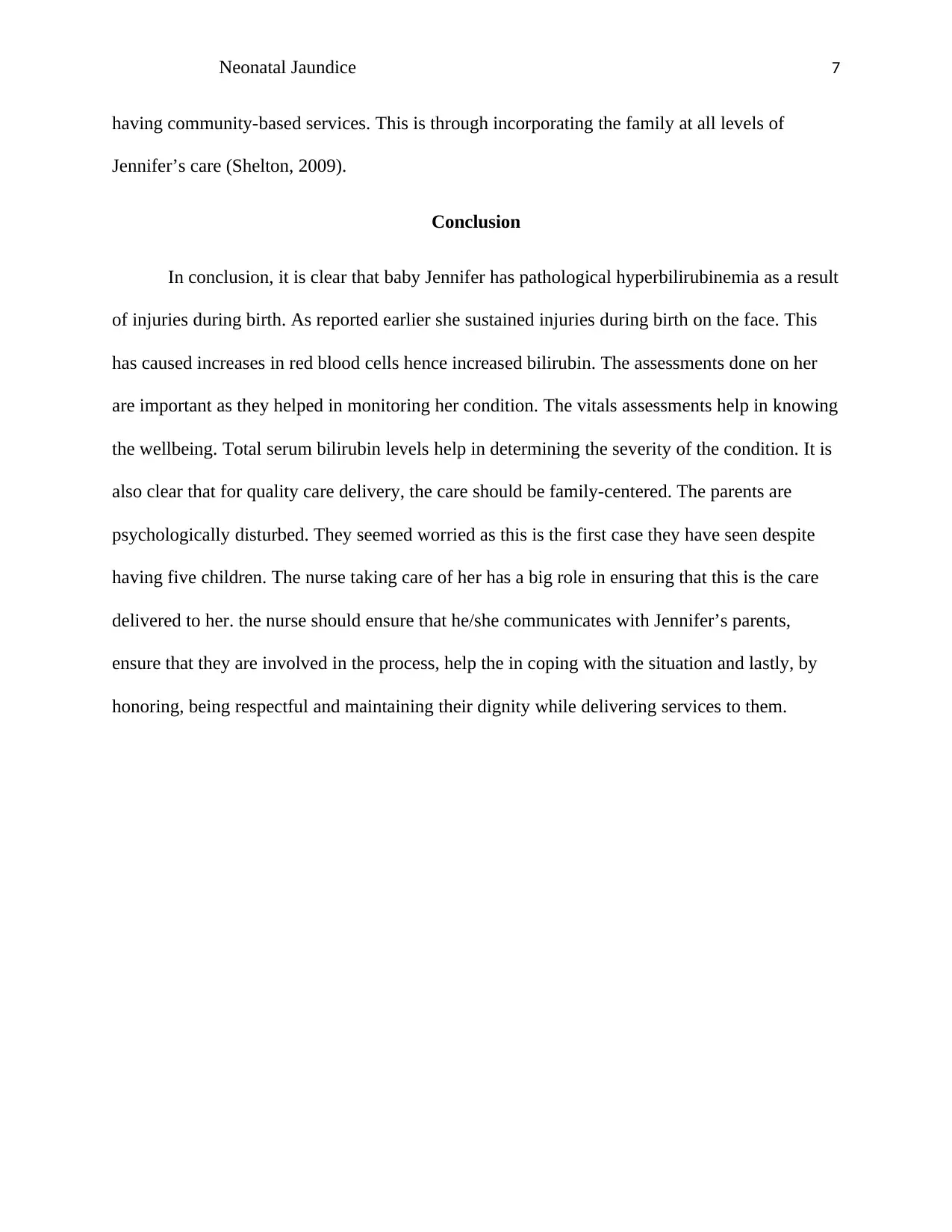
Neonatal Jaundice 7
having community-based services. This is through incorporating the family at all levels of
Jennifer’s care (Shelton, 2009).
Conclusion
In conclusion, it is clear that baby Jennifer has pathological hyperbilirubinemia as a result
of injuries during birth. As reported earlier she sustained injuries during birth on the face. This
has caused increases in red blood cells hence increased bilirubin. The assessments done on her
are important as they helped in monitoring her condition. The vitals assessments help in knowing
the wellbeing. Total serum bilirubin levels help in determining the severity of the condition. It is
also clear that for quality care delivery, the care should be family-centered. The parents are
psychologically disturbed. They seemed worried as this is the first case they have seen despite
having five children. The nurse taking care of her has a big role in ensuring that this is the care
delivered to her. the nurse should ensure that he/she communicates with Jennifer’s parents,
ensure that they are involved in the process, help the in coping with the situation and lastly, by
honoring, being respectful and maintaining their dignity while delivering services to them.
having community-based services. This is through incorporating the family at all levels of
Jennifer’s care (Shelton, 2009).
Conclusion
In conclusion, it is clear that baby Jennifer has pathological hyperbilirubinemia as a result
of injuries during birth. As reported earlier she sustained injuries during birth on the face. This
has caused increases in red blood cells hence increased bilirubin. The assessments done on her
are important as they helped in monitoring her condition. The vitals assessments help in knowing
the wellbeing. Total serum bilirubin levels help in determining the severity of the condition. It is
also clear that for quality care delivery, the care should be family-centered. The parents are
psychologically disturbed. They seemed worried as this is the first case they have seen despite
having five children. The nurse taking care of her has a big role in ensuring that this is the care
delivered to her. the nurse should ensure that he/she communicates with Jennifer’s parents,
ensure that they are involved in the process, help the in coping with the situation and lastly, by
honoring, being respectful and maintaining their dignity while delivering services to them.
Paraphrase This Document
Need a fresh take? Get an instant paraphrase of this document with our AI Paraphraser
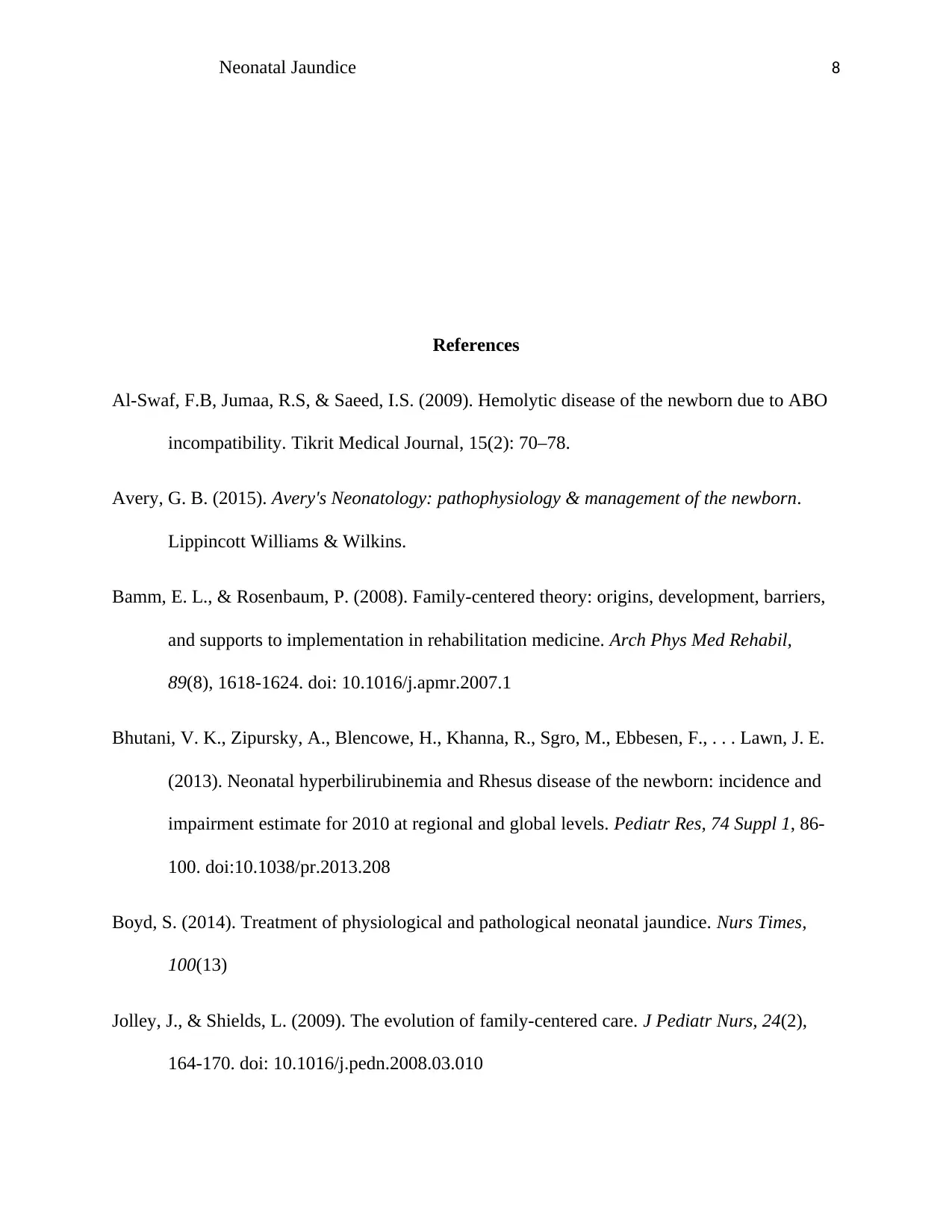
Neonatal Jaundice 8
References
Al-Swaf, F.B, Jumaa, R.S, & Saeed, I.S. (2009). Hemolytic disease of the newborn due to ABO
incompatibility. Tikrit Medical Journal, 15(2): 70–78.
Avery, G. B. (2015). Avery's Neonatology: pathophysiology & management of the newborn.
Lippincott Williams & Wilkins.
Bamm, E. L., & Rosenbaum, P. (2008). Family-centered theory: origins, development, barriers,
and supports to implementation in rehabilitation medicine. Arch Phys Med Rehabil,
89(8), 1618-1624. doi: 10.1016/j.apmr.2007.1
Bhutani, V. K., Zipursky, A., Blencowe, H., Khanna, R., Sgro, M., Ebbesen, F., . . . Lawn, J. E.
(2013). Neonatal hyperbilirubinemia and Rhesus disease of the newborn: incidence and
impairment estimate for 2010 at regional and global levels. Pediatr Res, 74 Suppl 1, 86-
100. doi:10.1038/pr.2013.208
Boyd, S. (2014). Treatment of physiological and pathological neonatal jaundice. Nurs Times,
100(13)
Jolley, J., & Shields, L. (2009). The evolution of family-centered care. J Pediatr Nurs, 24(2),
164-170. doi: 10.1016/j.pedn.2008.03.010
References
Al-Swaf, F.B, Jumaa, R.S, & Saeed, I.S. (2009). Hemolytic disease of the newborn due to ABO
incompatibility. Tikrit Medical Journal, 15(2): 70–78.
Avery, G. B. (2015). Avery's Neonatology: pathophysiology & management of the newborn.
Lippincott Williams & Wilkins.
Bamm, E. L., & Rosenbaum, P. (2008). Family-centered theory: origins, development, barriers,
and supports to implementation in rehabilitation medicine. Arch Phys Med Rehabil,
89(8), 1618-1624. doi: 10.1016/j.apmr.2007.1
Bhutani, V. K., Zipursky, A., Blencowe, H., Khanna, R., Sgro, M., Ebbesen, F., . . . Lawn, J. E.
(2013). Neonatal hyperbilirubinemia and Rhesus disease of the newborn: incidence and
impairment estimate for 2010 at regional and global levels. Pediatr Res, 74 Suppl 1, 86-
100. doi:10.1038/pr.2013.208
Boyd, S. (2014). Treatment of physiological and pathological neonatal jaundice. Nurs Times,
100(13)
Jolley, J., & Shields, L. (2009). The evolution of family-centered care. J Pediatr Nurs, 24(2),
164-170. doi: 10.1016/j.pedn.2008.03.010
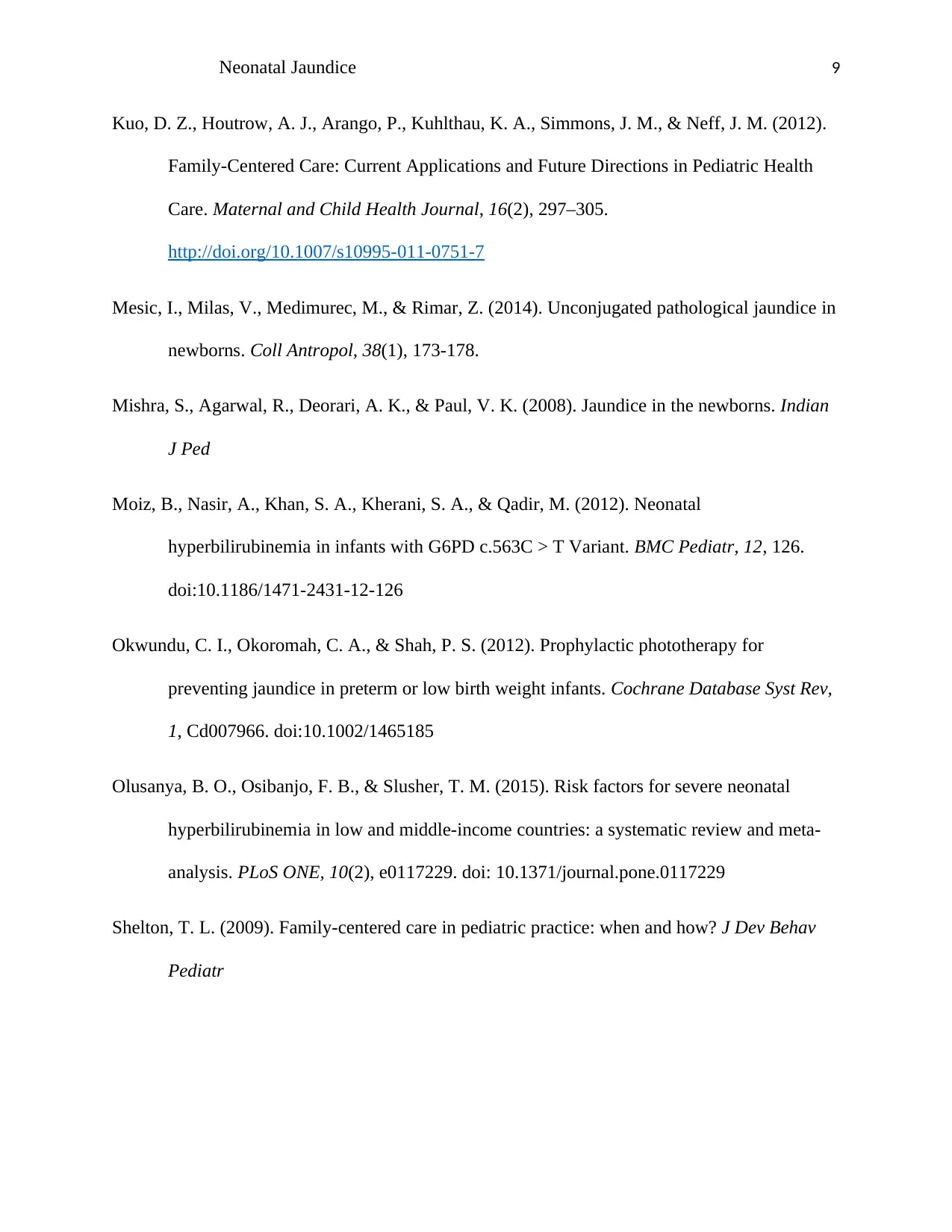
Neonatal Jaundice 9
Kuo, D. Z., Houtrow, A. J., Arango, P., Kuhlthau, K. A., Simmons, J. M., & Neff, J. M. (2012).
Family-Centered Care: Current Applications and Future Directions in Pediatric Health
Care. Maternal and Child Health Journal, 16(2), 297–305.
http://doi.org/10.1007/s10995-011-0751-7
Mesic, I., Milas, V., Medimurec, M., & Rimar, Z. (2014). Unconjugated pathological jaundice in
newborns. Coll Antropol, 38(1), 173-178.
Mishra, S., Agarwal, R., Deorari, A. K., & Paul, V. K. (2008). Jaundice in the newborns. Indian
J Ped
Moiz, B., Nasir, A., Khan, S. A., Kherani, S. A., & Qadir, M. (2012). Neonatal
hyperbilirubinemia in infants with G6PD c.563C > T Variant. BMC Pediatr, 12, 126.
doi:10.1186/1471-2431-12-126
Okwundu, C. I., Okoromah, C. A., & Shah, P. S. (2012). Prophylactic phototherapy for
preventing jaundice in preterm or low birth weight infants. Cochrane Database Syst Rev,
1, Cd007966. doi:10.1002/1465185
Olusanya, B. O., Osibanjo, F. B., & Slusher, T. M. (2015). Risk factors for severe neonatal
hyperbilirubinemia in low and middle-income countries: a systematic review and meta-
analysis. PLoS ONE, 10(2), e0117229. doi: 10.1371/journal.pone.0117229
Shelton, T. L. (2009). Family-centered care in pediatric practice: when and how? J Dev Behav
Pediatr
Kuo, D. Z., Houtrow, A. J., Arango, P., Kuhlthau, K. A., Simmons, J. M., & Neff, J. M. (2012).
Family-Centered Care: Current Applications and Future Directions in Pediatric Health
Care. Maternal and Child Health Journal, 16(2), 297–305.
http://doi.org/10.1007/s10995-011-0751-7
Mesic, I., Milas, V., Medimurec, M., & Rimar, Z. (2014). Unconjugated pathological jaundice in
newborns. Coll Antropol, 38(1), 173-178.
Mishra, S., Agarwal, R., Deorari, A. K., & Paul, V. K. (2008). Jaundice in the newborns. Indian
J Ped
Moiz, B., Nasir, A., Khan, S. A., Kherani, S. A., & Qadir, M. (2012). Neonatal
hyperbilirubinemia in infants with G6PD c.563C > T Variant. BMC Pediatr, 12, 126.
doi:10.1186/1471-2431-12-126
Okwundu, C. I., Okoromah, C. A., & Shah, P. S. (2012). Prophylactic phototherapy for
preventing jaundice in preterm or low birth weight infants. Cochrane Database Syst Rev,
1, Cd007966. doi:10.1002/1465185
Olusanya, B. O., Osibanjo, F. B., & Slusher, T. M. (2015). Risk factors for severe neonatal
hyperbilirubinemia in low and middle-income countries: a systematic review and meta-
analysis. PLoS ONE, 10(2), e0117229. doi: 10.1371/journal.pone.0117229
Shelton, T. L. (2009). Family-centered care in pediatric practice: when and how? J Dev Behav
Pediatr
⊘ This is a preview!⊘
Do you want full access?
Subscribe today to unlock all pages.

Trusted by 1+ million students worldwide
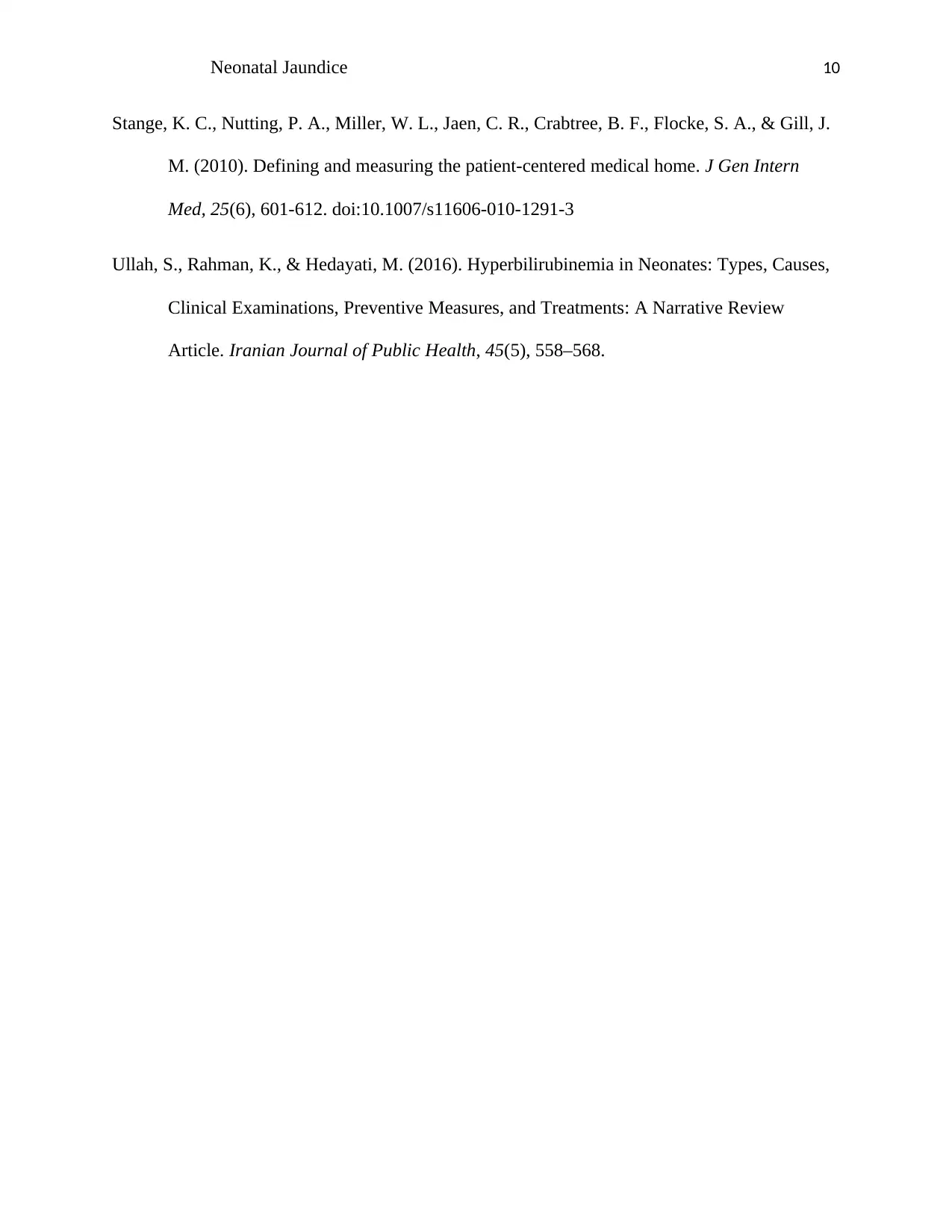
Neonatal Jaundice 10
Stange, K. C., Nutting, P. A., Miller, W. L., Jaen, C. R., Crabtree, B. F., Flocke, S. A., & Gill, J.
M. (2010). Defining and measuring the patient-centered medical home. J Gen Intern
Med, 25(6), 601-612. doi:10.1007/s11606-010-1291-3
Ullah, S., Rahman, K., & Hedayati, M. (2016). Hyperbilirubinemia in Neonates: Types, Causes,
Clinical Examinations, Preventive Measures, and Treatments: A Narrative Review
Article. Iranian Journal of Public Health, 45(5), 558–568.
Stange, K. C., Nutting, P. A., Miller, W. L., Jaen, C. R., Crabtree, B. F., Flocke, S. A., & Gill, J.
M. (2010). Defining and measuring the patient-centered medical home. J Gen Intern
Med, 25(6), 601-612. doi:10.1007/s11606-010-1291-3
Ullah, S., Rahman, K., & Hedayati, M. (2016). Hyperbilirubinemia in Neonates: Types, Causes,
Clinical Examinations, Preventive Measures, and Treatments: A Narrative Review
Article. Iranian Journal of Public Health, 45(5), 558–568.
1 out of 10
Your All-in-One AI-Powered Toolkit for Academic Success.
+13062052269
info@desklib.com
Available 24*7 on WhatsApp / Email
![[object Object]](/_next/static/media/star-bottom.7253800d.svg)
Unlock your academic potential
Copyright © 2020–2026 A2Z Services. All Rights Reserved. Developed and managed by ZUCOL.